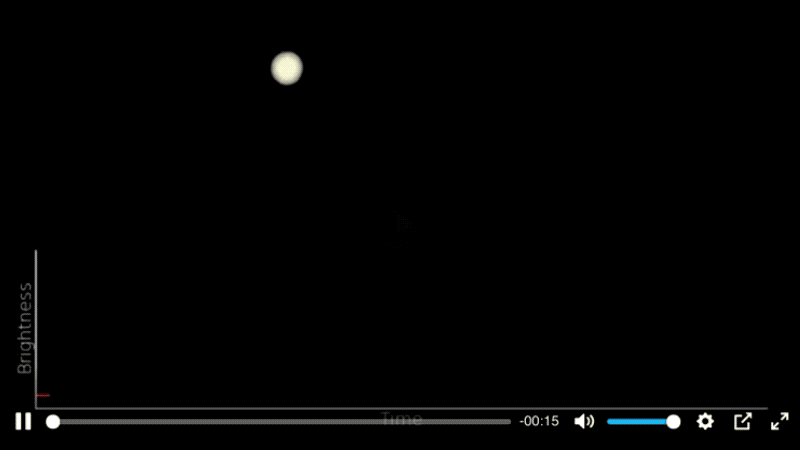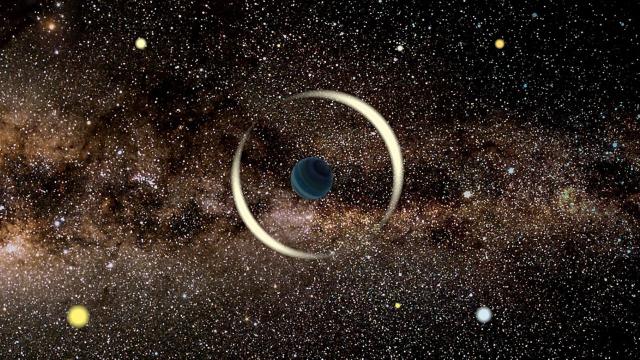Free-floating planets are not bound to any star, having been dumped from their original home systems. New research describes the smallest rogue planet discovered to date, in an astronomical achievement that took an Einstein-inspired technique to new extremes.
Rogue planets, also known as free-floating planets, aren’t gravitationally tethered to any star, which means they’re literally careening through interstellar space. That these things exist is kind of creepy, but rogue planets could be exceptionally common, with research from earlier this year claiming there could be trillions of them in the Milky Way.
Free-floating planets begin their wayward journeys after getting tossed out from their birthplace by powerful gravitational perturbations. And in fact, our very own Solar System may have lost such a planet, when Jupiter flung a newly formed planet into the depths of space some 4 billion years ago. The majority of rogue planets aren’t expected to be particularly big, with planet formation theories suggesting weights between 0.3 and 1 Earth masses, though they can include exoplanets the size of Jupiter.
[referenced id=”1303553″ url=”https://gizmodo.com.au/2020/08/trillions-of-rogue-planets-could-be-careening-through-our-galaxy/” thumb=”https://gizmodo.com.au/wp-content/uploads/2020/08/26/ryj3yjyqtg9fwblwqp62-300×169.gif” title=”Trillions of Rogue Planets Could Be Careening Through Our Galaxy” excerpt=”A new estimate suggests the Milky Way contains more free-floating planets than stars. It’s a big claim, but an upcoming mission might actually prove it.”]
In new research published last week in The Astrophysical Journal, a Polish-led team of astronomers report on the smallest rogue planet ever discovered. Their work jibes well with the idea that most rogue planets are relatively small. As the new study shows, the mass of the newly detected rogue planet is somewhere between 0.3 Earth masses and 2.0 Earth masses (by comparison, Mars is just over 0.1 Earth masses). But data gathered by the Gaia Collaboration suggests it’s closer to the smaller figure, so it’s probably a “sub-Earth-mass object,” as the researchers describe it.
Free-floating planets may be abundant, but they’re notoriously difficult to detect. Normally, exoplanets are spotted when they pass in front of a host star from our perspective, causing a temporary drop in luminosity (this is known as the transit method of detection). Should it happen again a few days, months, or years later, scientists know they’re dealing with an exoplanet that’s bound to its host star. This doesn’t apply to rogue planets, requiring scientists to rely on another method — one predicted by Albert Einstein’s general theory of relativity.
It’s called gravitational lensing, and, like the transit method, it involves the conjunction of two stellar objects from our perspective. But instead of a dimming star, the conjunction bends light, forming a temporary ring around the foreground object.

“If a massive object (a star or a planet) passes between an Earth-based observer and a distant source star, its gravity may deflect and focus light from the source,” Przemek Mroz, the lead author of the new study and a postdoctoral scholar at the California Institute of Technology, explained in a University of Warsaw statement. “Chances of observing microlensing are extremely slim because three objects — source, lens, and observer — must be nearly perfectly aligned. If we observed only one source star, we would have to wait almost a million years to see the source being microlensed.”
Mroz and his colleagues are members of OGLE (Optical Gravitational Lensing Experiment), and they used the 4.4-foot (1.3-metre) Warsaw Telescope at Las Campanas Observatory in Chile to make the discovery. The OGLE team is proficient at using this technique, having detected many rogue planets before. To increase the odds of a detection, the team pointed their telescope to the star-dense galactic bulge of the Milky Way, which resulted in the detection of the microlensing event, named OGLE-2016-BLG-1928.
In addition to the gravitational light ring, the astronomers considered another important factor: the duration of the lensing event. Really massive objects can create microlensing events that last for days, while some rogue planets can produce events lasting for a few hours. These measurements are important because duration can be used to estimate the mass of the lensing object.
Because OGLE-2016-BLG-1928 lasted a mere 42 minutes, it likely means we’re dealing with relatively low-mass object. The estimated size of the object is somewhere between that of Mars and Earth, with the authors saying it’s most likely around three times the size of Mars. At 42 minutes, it’s the “most extreme short-timescale microlens discovered to date,” according to the study, with the researchers adding: “The properties of OGLE-2016-BLG-1928 place it at the edge of current limits of detecting short-timescale microlensing events and highlight the challenges that will be faced by future surveys for extremely short timescale events.”
It’s possible that this exoplanet actually does orbit a star, but the scientists couldn’t find it. Or least, they couldn’t find a star within 8 AU of the object, with 1 AU being the average distance from Earth to the Sun. Andrzej Udalski, the principal investigator of the OGLE project, said the new paper shows that “low-mass free-floating planets can be detected and characterised using ground-based telescopes.”
Sadly, this is all we know about this little lost planet. Other information, such as its chemical composition or temperature, cannot be known at this time owing to astronomical limitations. Hopefully we’ll be able to learn those details in the future, as we continue to investigate these fascinating objects.
